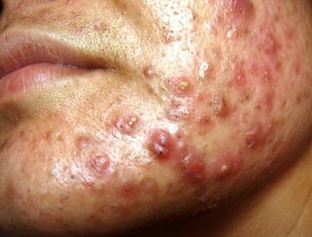Among the many different dermatological pathologies, one of the most common, unpleasant and complex is acne. The disease develops in more than 80% of adolescents, and in almost a quarter of people aged 20 to 40.
A characteristic manifestation of this pathology – the formation of acne on the skin, which not only worsen the appearance of the patient, but also often cause the development of psychological problems. In some cases, patients with acne develop an even more severe manifestation of – conglobate acne. Why is this problem formed, what is it characterized by and how to deal with it – read on estet-portal.com right now.
Acne conglobata: etiology, clinical picture and treatment
Conglobate acne – this is one of the most severe manifestations of acne, occurring in almost 15-25% of patients with this pathology.
Acne conglobata is also called multiple or piled up, and is a gradual developing, long-term, chronic, relapsing form of acne.
Pathology occurs more often in males, and is characterized by the fusion of isolated comedones, as a result of which, in the deep layers of the dermis and epidermis around the inflamed hair follicles, a complex of rounded and painful formations of a bluish-purple color, which are inflammatory infiltrates, is formed.
Acne conglobata:
- clinical picture of acne conglobata: features of the pathology;
- major causes of acne conglobata;
- systemic and topical treatment of acne conglobata.
Clinical picture of acne conglobata: features of the pathology
Acne conglobate is most often localized on the scalp and neck, on the face, back, upper parts of the anterior surface of the chest, and less often – on the stomach. Infiltrates and cysts communicate with each other and with the surface of the skin through fistulas – epithelized canals through which purulent contents are released during exacerbations.
Quite often, boils and abscesses also occur, and at the site of inflammatory infiltrates, as a result, keloid scars can form. Conglobate acne is often combined with folliculitis and perifolliculitis in the scalp, and recurrent purulent inflammation of the sebaceous and sweat apocrine glands. They are also characterized by a tendency to form sebaceous cysts.

The main causes of acne conglobata
Among the main causes of acne conglobata are:
- genetically determined hyperandrogenism, which is characterized by an absolute increase in the male sex hormones androgens in the blood;
- decrease in testosterone activity as a result of impaired ability of sex-binding globulin (SSBG) to bind it;
- the receptor form of hyperandrogenism, in which the absolute content of androgens in the blood is normal or slightly reduced, and the sensitivity of hair follicle receptors to testosterone or dehydrotestosterone is increased.
These factors contribute to the increase in sebum production, and together create favorable conditions for the development of pathogenic microflora. As a result of exposure to a combination of factors, the walls of the sebaceous glands are damaged and destroyed, their contents enter the dermis, inflammatory reactions, infiltrates and cystic formations occur.
Systemic and topical treatment of acne conglobata
Treatment of acne conglobata consists in elimination of etiological factors and prescribing both topical and systemic drugs.
Topical remedies include:
- emulsions and ointments with antibacterial preparations;
- retinoids in various forms;
- hardware treatments such as laser therapy, microcurrents, oxygen-ozone therapy and others.
Systemic therapy for multiple acne includes:
- introduction of antibacterial agents according to the schemes;
- use of combined oral contraceptives to normalize hormonal levels;
- oral retinoids;
- preparations with vitamins and microelements.
Conglobate acne – this is a severe form of acne, which can only be cured by an experienced and highly qualified specialist. An integrated approach and properly selected treatment make it possible to maximize the period of remission, and even completely eliminate the problem. estet-portal.com thanks you for your attention.
You may also be interested in: «Acne Treatment: State of the Problem and New Opportunities».







Add a comment